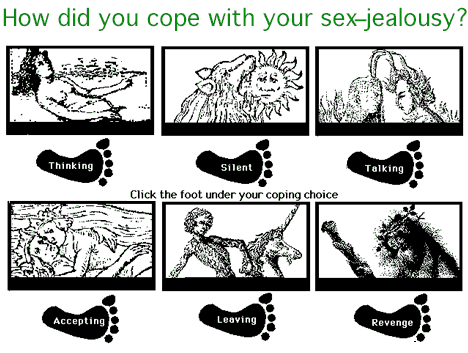
SEXUAL JEALOUSY: The Shadow of Love is an interactive Hypercard artwork where participants investigate the sources of their jealousy and the methods for coping with their feelings. The work was originally conceived in 1984 as an audience participation performance called Coping with Sexual Jealousy. It was produced at the Pauley Ballroom, University of California, Berkeley as an audience participation performance with installations by Judy Malloy, Helen Holt, Tom Patrick, and Sam Samore. SEXUAL JEALOUSY: The Shadow of Love, the Hypercard version, was installed at FISEA, the Fourth International Symposium of Electronic Art, at Minneapolis in 1993. Michael McNabb composed the music for the presentation. Whereas the audience in the earlier version physically acted out their feelings, the Hypercard program uses the computer to ask questions that probe this intensely personal and currently highly visible subject. When the participants answer questions about their priorities in choice of mate, feelings of loss, and methods of coping, they become aware of the sources of their jealousy. The reward for following through the routine is a personalized "shadow" message.
How you are jealous reflects what attracted you to that person. That is why jealousy is the shadow of love. "Attraction" sequences are "played" by Indonesian shadow puppets. Soap opera clips illustrate the several methods for coping with sexual jealousy. Depending on the attraction and coping choices made by the participant, the computer prints out a "shadow message" which has been excerpted from a movie script.
Accompanying the text three layers of illustrations are orchestrated throughout the program: Aubrey Beardsley drawings, Indonesian shadow puppets, and Jungian mythological images. Dr. Ayala Pines has been the consulting psychologist from its inception. The "shadow" messages are from movie scripts that relate to the user's situation. Paul Tompkins was computer programming consultant.